Inglourious Basterds
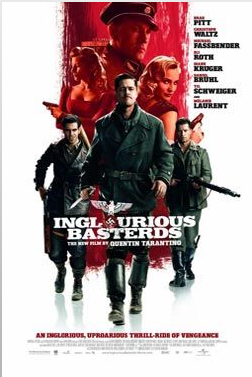
Quentin Tarantino's Inglourious Basterds is not quite the all-out crazy, fast-paced World War II revisionist film that I was expecting. Many of its scenes are intentionally leisurely paced, mounting the tension through Tarantino's use of dialogue. The tension builds until it explodes into a brief frenzy of violence. It's a successful formula, for the most part. Some scenes are a bit too self-indulgent in its dialogue, and in the process end up going on longer than they should. It's a mixed bag to be sure, but the good definitely outweighs the bad, or in this case, the somewhat disappointing.
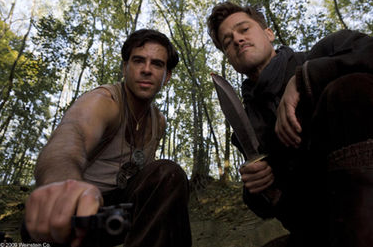 The film's structure is divided into five individual chapters. The first four are focused on a certain character, or characters, who plays a large role in the overall story. In the opening chapter, we're introduced to SS Colonel Hans Landa (Christoph Waltz). Nicknamed "The Jew Hunter", he has a calm and almost charming manner about him as he pays a visit to a local farmer who is harboring Jewish refugees under his floorboards. This entire sequence (which seems to last for over 20 minutes), introduces us not only to the character of Hans (who is perhaps the most memorable Nazi villain on film since Ralph Fiennes in Schindler's List), but also to the film's gift of dialogue. It creates an incredible amount of tension, even though Hans or the farmer he is questioning never raise their voices once. Their conversation is casual and serene, but we can see the intensity in their faces as they try to break one another's will. It's a wonderful scene, and the ensuing violence when the refugees are discovered is all the more shocking considering the tone of the entire conversation. One of the women who was hiding under the floorboards manages to escape, and will play a larger role in a future chapter.
The film's structure is divided into five individual chapters. The first four are focused on a certain character, or characters, who plays a large role in the overall story. In the opening chapter, we're introduced to SS Colonel Hans Landa (Christoph Waltz). Nicknamed "The Jew Hunter", he has a calm and almost charming manner about him as he pays a visit to a local farmer who is harboring Jewish refugees under his floorboards. This entire sequence (which seems to last for over 20 minutes), introduces us not only to the character of Hans (who is perhaps the most memorable Nazi villain on film since Ralph Fiennes in Schindler's List), but also to the film's gift of dialogue. It creates an incredible amount of tension, even though Hans or the farmer he is questioning never raise their voices once. Their conversation is casual and serene, but we can see the intensity in their faces as they try to break one another's will. It's a wonderful scene, and the ensuing violence when the refugees are discovered is all the more shocking considering the tone of the entire conversation. One of the women who was hiding under the floorboards manages to escape, and will play a larger role in a future chapter.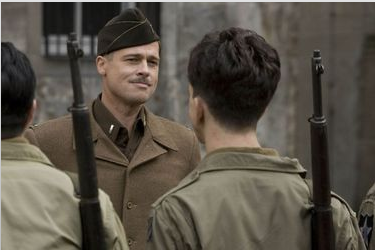 In the next segment, we're introduced to the Basterds themselves. They're a gung-ho group of Americans who are under the command of Lt. Aldo Raine (Brad Pitt), a fast-talking Southerner who wants one thing and one thing only - the scalped heads of as many Nazi soldiers they can find. The few Nazis they choose to let live are branded for life with a swastika that Aldo carves into their forehead with a knife. Even though Brad Pitt is at the center of the film's ad campaign, he actually has limited screen time in comparison to Shosanna Dreyfus (Melanie Laurent), who is the focus of the third chapter. She's the woman who escaped from the farm in the opening scene, and has since been running a movie theater in German-occupied France under a fake name. When she is approached to hold a grand premiere of a Nazi propaganda film at her theater, she begins to plot to blow up the building with everyone inside during the screening as a desperate act of revenge. This ties into Chapter 4, where a German actress serving as a double agent named Bridget von Hammersmart (Diane Kuger) teams up with the Basterds to get them inside the movie premiere to pull off an assassination plan of their own. It all builds to Chapter 5, where all the characters and storylines come together for one explosive finale the night of the premiere.
In the next segment, we're introduced to the Basterds themselves. They're a gung-ho group of Americans who are under the command of Lt. Aldo Raine (Brad Pitt), a fast-talking Southerner who wants one thing and one thing only - the scalped heads of as many Nazi soldiers they can find. The few Nazis they choose to let live are branded for life with a swastika that Aldo carves into their forehead with a knife. Even though Brad Pitt is at the center of the film's ad campaign, he actually has limited screen time in comparison to Shosanna Dreyfus (Melanie Laurent), who is the focus of the third chapter. She's the woman who escaped from the farm in the opening scene, and has since been running a movie theater in German-occupied France under a fake name. When she is approached to hold a grand premiere of a Nazi propaganda film at her theater, she begins to plot to blow up the building with everyone inside during the screening as a desperate act of revenge. This ties into Chapter 4, where a German actress serving as a double agent named Bridget von Hammersmart (Diane Kuger) teams up with the Basterds to get them inside the movie premiere to pull off an assassination plan of their own. It all builds to Chapter 5, where all the characters and storylines come together for one explosive finale the night of the premiere.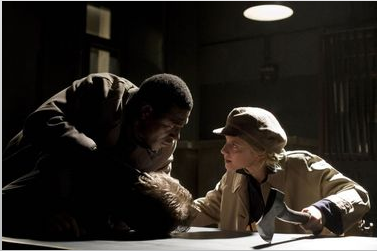 Calling Inglourious Basterds a war movie is quite a disservice, as it's also features nods to Spaghetti Westerns, exploitation, and over the top revenge films. Tarantino manages to keep things pretty much under control, however. Despite the multi-plot structure and large cast of leads, it never becomes confusing or overbearing. It does come dangerously close to slowing to a halt a couple times, though. That's because Tarantino apparently loves his own dialogue so much, he seems to have refused to cut a single word of his screenplay. Therefore, we get scenes that go on for literally 30 minutes or more, with just the characters sitting at a table, talking. In some instances, this is wonderful and highly suspenseful (such as the previously mentioned opening scene at the farm). But there are some sequences, such as one based around a 20 questions-like game in a tavern, that had me fidgeting just a little. It's not so much I found the dialogue bad, I just did not find the pacing of the conversation as tense. I also found the Basterds themselves largely uninteresting. Despite Brad Pitt's winning and often very funny performance, they never come across as real three dimensional characters. Maybe that was the point, but I found myself much more interested in the plot that theater owner Shosanna Dreyfus was hatching, other than the one Aldo and his men were.
Calling Inglourious Basterds a war movie is quite a disservice, as it's also features nods to Spaghetti Westerns, exploitation, and over the top revenge films. Tarantino manages to keep things pretty much under control, however. Despite the multi-plot structure and large cast of leads, it never becomes confusing or overbearing. It does come dangerously close to slowing to a halt a couple times, though. That's because Tarantino apparently loves his own dialogue so much, he seems to have refused to cut a single word of his screenplay. Therefore, we get scenes that go on for literally 30 minutes or more, with just the characters sitting at a table, talking. In some instances, this is wonderful and highly suspenseful (such as the previously mentioned opening scene at the farm). But there are some sequences, such as one based around a 20 questions-like game in a tavern, that had me fidgeting just a little. It's not so much I found the dialogue bad, I just did not find the pacing of the conversation as tense. I also found the Basterds themselves largely uninteresting. Despite Brad Pitt's winning and often very funny performance, they never come across as real three dimensional characters. Maybe that was the point, but I found myself much more interested in the plot that theater owner Shosanna Dreyfus was hatching, other than the one Aldo and his men were.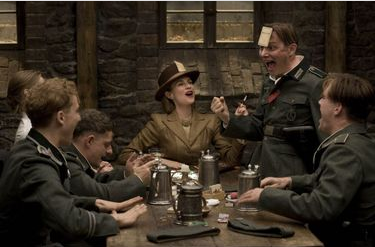 Speaking of the performances, Laurent's turn as Shosanna is definitely one of the highlights. This is the first time I have seen her in a film, and she almost walks away with the entire movie. A lot of this has to do with the fact that we sympathize with her the most. She's the only character with a real background story, so we feel the most attached to her. The other main highlight is Christoph Waltz as the main Nazi villain. He is the perfect combination of charm and menace. He smiles brightly, is soft-spoken, and hardly (if ever) brandishes a weapon. It is his manipulation and his use of words that make him chilling, and hopefully a strong contender come Award time next year. The other performances are strong, but don't stand out as much, due to the screenplay treating them as avatars rather than actual people. I have a strong hunch that were it not for Pitt's performance, the character of Aldo would be a lot less memorable than he comes across.
Speaking of the performances, Laurent's turn as Shosanna is definitely one of the highlights. This is the first time I have seen her in a film, and she almost walks away with the entire movie. A lot of this has to do with the fact that we sympathize with her the most. She's the only character with a real background story, so we feel the most attached to her. The other main highlight is Christoph Waltz as the main Nazi villain. He is the perfect combination of charm and menace. He smiles brightly, is soft-spoken, and hardly (if ever) brandishes a weapon. It is his manipulation and his use of words that make him chilling, and hopefully a strong contender come Award time next year. The other performances are strong, but don't stand out as much, due to the screenplay treating them as avatars rather than actual people. I have a strong hunch that were it not for Pitt's performance, the character of Aldo would be a lot less memorable than he comes across.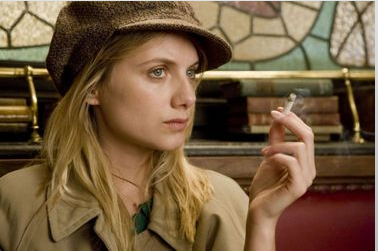 If I was somewhat disappointed with the storytelling, the visual style of the film helped me get over any hurdles. This is easily Tarantino's best looking film yet, with grand wide shots, and tight close ups that manage to up the tension as much as the dialogue in many of the scenes. The climactic sequence at the movie theater is just as explosive as any action sequence you can find this summer, probably more so. But it's the way he stages his smaller scenes that impressed me. He gets so much out of his performers, you can almost look forward to an acting highlight in nearly every scene. The only thing that took me out of the movie is his tendency to dip into stunt casting. Horror filmmaker Eli Roth (best known for directing the Hostel films) shows up in a small role as one of the Basterds, who has a passion for bashing Nazi's skulls in with a baseball bat for the entertainment of his fellow men. ("It's the closest thing we have to a movie", Aldo says.) It's not quite as distracting as it would have been if Tarantino initially got his way, however. Originally, he wanted Adam Sandler to play the role, but fortunately Funny People got in the way. More distracting, though, is a strange cameo by comic actor Mike Myers as a British General during a mission briefing scene. He sticks out like a sore thumb, and briefly takes us out of the film.
If I was somewhat disappointed with the storytelling, the visual style of the film helped me get over any hurdles. This is easily Tarantino's best looking film yet, with grand wide shots, and tight close ups that manage to up the tension as much as the dialogue in many of the scenes. The climactic sequence at the movie theater is just as explosive as any action sequence you can find this summer, probably more so. But it's the way he stages his smaller scenes that impressed me. He gets so much out of his performers, you can almost look forward to an acting highlight in nearly every scene. The only thing that took me out of the movie is his tendency to dip into stunt casting. Horror filmmaker Eli Roth (best known for directing the Hostel films) shows up in a small role as one of the Basterds, who has a passion for bashing Nazi's skulls in with a baseball bat for the entertainment of his fellow men. ("It's the closest thing we have to a movie", Aldo says.) It's not quite as distracting as it would have been if Tarantino initially got his way, however. Originally, he wanted Adam Sandler to play the role, but fortunately Funny People got in the way. More distracting, though, is a strange cameo by comic actor Mike Myers as a British General during a mission briefing scene. He sticks out like a sore thumb, and briefly takes us out of the film.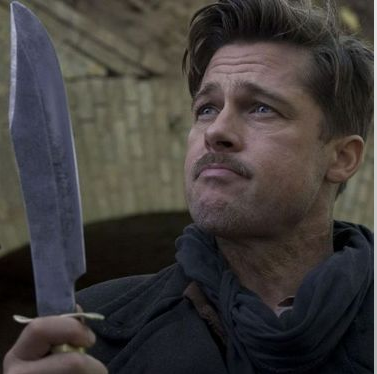
See the movie times in your area or buy the DVD at Amazon.com!






0 Comments:
Post a Comment
<< Home